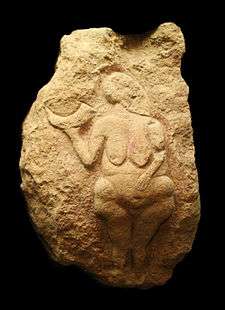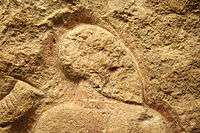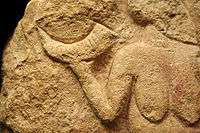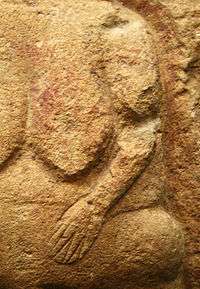Venus of Laussel




The Venus of Laussel is an 18.11-inch high limestone bas-relief of a nude female figure or Venus figurine. It is painted with red ochre and was carved into a large block of fallen limestone in a rock shelter (Abri de Laussel) in the commune of Marquay, in the Dordogne department of south-western France. The carving is associated with the Gravettian Upper Paleolithic culture (approximately 25,000 years old). It is currently displayed in the Musée d'Aquitaine in Bordeaux, France.
Description
The figure holds a bison horn, or possibly a cornucopia, in one hand, which has thirteen notches. According to some researchers, this may symbolize the number of moons or the number of menstrual cycles in one year.
Alexander Marshack said about the Venus of Laussel that "One cannot conjecture on the basis of one engraved sequence any meaning to the marks, but that the unusually clean horn was notated with storied marks is clear."[1]
She has her hand on her abdomen (or womb), with large breasts and vulva. There is a "Y" on her thigh and her faceless head is turned toward the horn.
Discovery and display
The figure was discovered in 1911 by Jean-Gaston Lalanne, a physician. It was carved into large block of limestone in a rock shelter (abri de Laussel) at the commune of Marquay in the Dordogne department of south-western France. It is now in the Musée d'Aquitaine in Bordeaux, France.
See also
References
- ↑ Marshack, p. 335.
Works cited
- Marshack, Alexander (1991), The Roots of Civilization, Moyer Bell Ltd, Mount Kisco, NY.
External links
| Wikimedia Commons has media related to Venus of Laussel. |